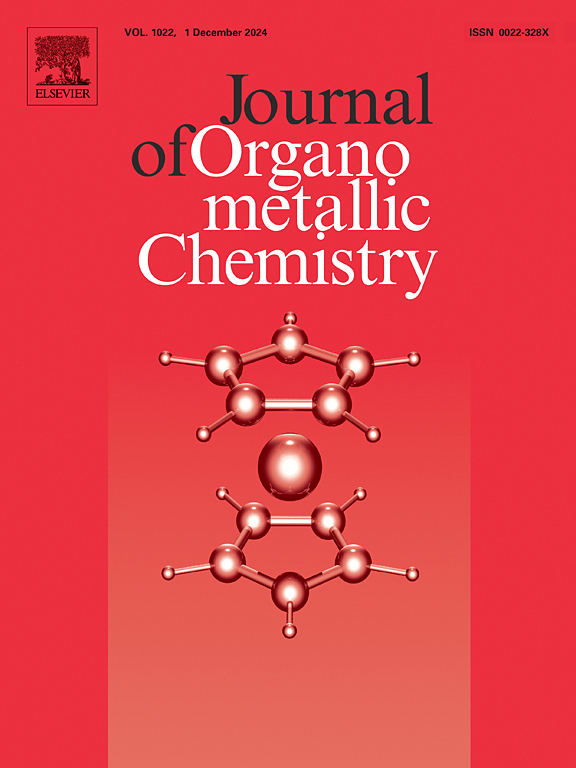A new Pd(II) catalyst supported on magnetic SBA-15 for the Mizoroki-Heck coupling reaction
IF 2.1
3区 化学
Q3 CHEMISTRY, INORGANIC & NUCLEAR
引用次数: 0
Abstract
This study details the anchoring of a linear polyamine-Pd(II) complex on magnetite/SBA-15 composite. The synthesis involved sequential treatment of magnetic mesoporous silica with (3-aminopropyl) triethoxysilane (APTES), trichlorotriazine, tetraethylenepentamine (TEPA), PdCl2, and sodium acetate, resulting in the formation of Fe3O4@SBA-TEPA-Pd(II). The supported complex was thoroughly characterized using standard analytical techniques. X-ray photoelectron spectroscopy (XPS) further confirmed the presence of both Pd(II) and Pd(0) species within the material. The catalytic activity of Fe3O4@SBA-TEPA-Pd(II) was systematically investigated in the Mizoroki-Heck cross-coupling reaction, with a detailed examination of the influences of various reaction parameters. The reaction was optimized using N-methylpyrrolidone (NMP) as the solvent, a 0.36 mol % Pd catalyst, K2CO3 as the base, and a reaction temperature of 120 °C. Under these conditions, the Fe3O4@SBA-TEPA-Pd(II) catalyst exhibited a broad substrate scope, efficiently reacting with a range of haloarenes (I, Br, Cl) and olefins. The catalyst demonstrated several practical benefits, including facile magnetic separation, high stability, recyclability over six cycles, and minimal palladium leaching of 0.1 %.

磁性SBA-15负载Pd(II)催化剂用于Mizoroki-Heck偶联反应
本研究详细介绍了线性多胺- pd (II)配合物在磁铁矿/SBA-15复合材料上的锚定。合成过程包括用(3-氨基丙基)三乙氧基硅烷(APTES)、三氯三嗪、四乙基戊二胺(TEPA)、PdCl2和乙酸钠对磁性介孔二氧化硅进行顺序处理,形成Fe3O4@SBA-TEPA-Pd(II)。采用标准分析技术对负载配合物进行了全面表征。x射线光电子能谱(XPS)进一步证实了材料中存在Pd(II)和Pd(0)两种物质。系统研究了Fe3O4@SBA-TEPA-Pd(II)在Mizoroki-Heck交叉偶联反应中的催化活性,并详细考察了各种反应参数对其催化活性的影响。以n -甲基吡咯烷酮(NMP)为溶剂,钯浓度为0.36 mol %, K2CO3为碱,反应温度为120℃为优化条件。在这些条件下,Fe3O4@SBA-TEPA-Pd(II)催化剂表现出广泛的底物范围,与一系列卤代芳烃(I, Br, Cl)和烯烃有效反应。该催化剂具有多种实际优势,包括易磁分离、高稳定性、6次循环可回收性和0.1%的钯浸出率。
本文章由计算机程序翻译,如有差异,请以英文原文为准。
求助全文
约1分钟内获得全文
求助全文
来源期刊

Journal of Organometallic Chemistry
化学-无机化学与核化学
CiteScore
4.40
自引率
8.70%
发文量
221
审稿时长
36 days
期刊介绍:
The Journal of Organometallic Chemistry targets original papers dealing with theoretical aspects, structural chemistry, synthesis, physical and chemical properties (including reaction mechanisms), and practical applications of organometallic compounds.
Organometallic compounds are defined as compounds that contain metal - carbon bonds. The term metal includes all alkali and alkaline earth metals, all transition metals and the lanthanides and actinides in the Periodic Table. Metalloids including the elements in Group 13 and the heavier members of the Groups 14 - 16 are also included. The term chemistry includes syntheses, characterizations and reaction chemistry of all such compounds. Research reports based on use of organometallic complexes in bioorganometallic chemistry, medicine, material sciences, homogeneous catalysis and energy conversion are also welcome.
The scope of the journal has been enlarged to encompass important research on organometallic complexes in bioorganometallic chemistry and material sciences, and of heavier main group elements in organometallic chemistry. The journal also publishes review articles, short communications and notes.
 求助内容:
求助内容: 应助结果提醒方式:
应助结果提醒方式:


